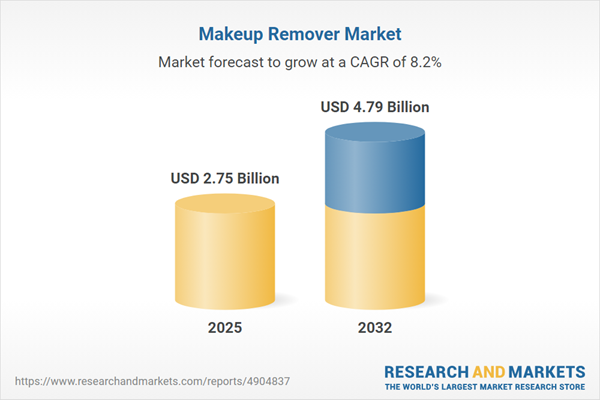Speak directly to the analyst to clarify any post sales queries you may have.
The makeup remover market is evolving rapidly, driven by consumer demand for convenient, gentle, and effective solutions. Strategic insights into shifting regulatory frameworks, technological advances, and segmentation are increasingly essential for senior decision-makers seeking resilient growth and competitive differentiation.
Market Snapshot: Makeup Remover Market Trends & Growth Outlook
The global makeup remover market grew from USD 2.54 billion in 2024 to USD 2.75 billion in 2025 and is projected to reach USD 4.79 billion by 2032, with a CAGR of 8.24%. This robust expansion is underpinned by the convergence of shifting demographics, regulatory initiatives, and technological innovation. Companies are experiencing dynamic competition as digital commerce platforms accelerate market accessibility and broaden consumer touchpoints.
Scope & Segmentation
This report delivers an in-depth analysis of all critical dimensions shaping the makeup remover industry landscape across distribution channels, ingredient types, user demographics, skin types, product forms, global regions, and leading vendors.
- Distribution Channels: Offline retailers such as pharmacy drug stores, specialty stores, supermarkets, and hypermarkets; online platforms including direct-to-consumer e-commerce.
- Ingredient Types: Natural/organic (vegan and non-vegan formulations); synthetic, including mineral oil-based and surfactant-based variants.
- End Users: Female and male demographics, with tailored formulations and marketing strategies.
- Skin Types: Combination, dry, normal, oily, and sensitive, leading to diversification in product innovation.
- Product Forms: Cleansing wipes, cream cleansers, foam cleansers, micellar water, oil cleansers.
- Regions: Americas (United States, Canada, Mexico, Brazil, Argentina, Chile, Colombia, Peru), Europe, Middle East, and Africa (United Kingdom, Germany, France, Russia, Italy, Spain, Netherlands, Sweden, Poland, Switzerland, UAE, Saudi Arabia, Qatar, Turkey, Israel, South Africa, Nigeria, Egypt, Kenya), and Asia-Pacific (China, India, Japan, Australia, South Korea, Indonesia, Thailand, Malaysia, Singapore, Taiwan).
- Leading Companies: L'Oreal S.A., Procter & Gamble Co., Unilever PLC, Estée Lauder Companies Inc., Johnson & Johnson, Beiersdorf AG, Shiseido Company, Limited, Kao Corporation, LVMH Moët Hennessy Louis Vuitton SE, e.l.f. Beauty, Inc.
Key Takeaways for Senior Decision-Makers
- Sustainability is now a key brand differentiator, with consumer and regulatory pressures driving adoption of recyclable packaging and ethically sourced ingredients.
- Digital commerce, including AR try-ons and personalized skin assessments, is redefining customer engagement and purchasing decisions.
- Compliance with diverse global regulatory standards is increasingly important, requiring agile R&D and supply chain responses.
- Ingredient innovation and transparent labeling remain critical, as consumers scrutinize products for safety, purity, and skin compatibility.
- Regional strategies must be customized, as consumer behaviors, product preferences, and regulatory requirements vary significantly across Americas, EMEA, and Asia-Pacific markets.
- The contract manufacturing sector and private label offerings provide opportunities for retailers to differentiate and optimize margins.
Tariff Impact: Navigating Supply Chain and Cost Challenges
Recent United States tariff adjustments impact raw material costs, prompting many manufacturers to restructure supplier networks, accelerate qualification timelines, and invest in domestic or alternative sourcing. These challenges are influencing both product formulation and pricing strategies. Some brands now invest in local manufacturing and scenario planning to mitigate ongoing cost pressures.
Methodology & Data Sources
This analysis utilizes a robust methodology, integrating expert interviews with manufacturers, suppliers, buyers, and dermatology professionals. Key insights are drawn from secondary research, including regulatory filings and market databases. Rigorous data triangulation and peer-review ensure the integrity and actionable value of all findings.
Why This Makeup Remover Market Report Matters
- Enables C-suite leaders to anticipate shifting market drivers with actionable segment-level insights and technology trend forecasts.
- Supports effective scenario planning and resource allocation by providing a granular, validated view of supply chain and regulatory risks.
Conclusion
Decision-makers receive a comprehensive framework to navigate sustainability imperatives, digital transformation, and operational headwinds. This resource guides investment and strategic planning for enduring market relevance and profitable growth.
Additional Product Information:
- Purchase of this report includes 1 year online access with quarterly updates.
- This report can be updated on request. Please contact our Customer Experience team using the Ask a Question widget on our website.
Table of Contents
3. Executive Summary
4. Market Overview
7. Cumulative Impact of Artificial Intelligence 2025
List of Figures
Samples

LOADING...
Companies Mentioned
The key companies profiled in this Makeup Remover market report include:- L'Oreal S.A.
- Procter & Gamble Co.
- Unilever PLC
- Estée Lauder Companies Inc.
- Johnson & Johnson
- Beiersdorf AG
- Shiseido Company, Limited
- Kao Corporation
- LVMH Moët Hennessy Louis Vuitton SE
- e.l.f. Beauty, Inc.
Table Information
| Report Attribute | Details |
|---|---|
| No. of Pages | 181 |
| Published | October 2025 |
| Forecast Period | 2025 - 2032 |
| Estimated Market Value ( USD | $ 2.75 Billion |
| Forecasted Market Value ( USD | $ 4.79 Billion |
| Compound Annual Growth Rate | 8.2% |
| Regions Covered | Global |
| No. of Companies Mentioned | 11 |









